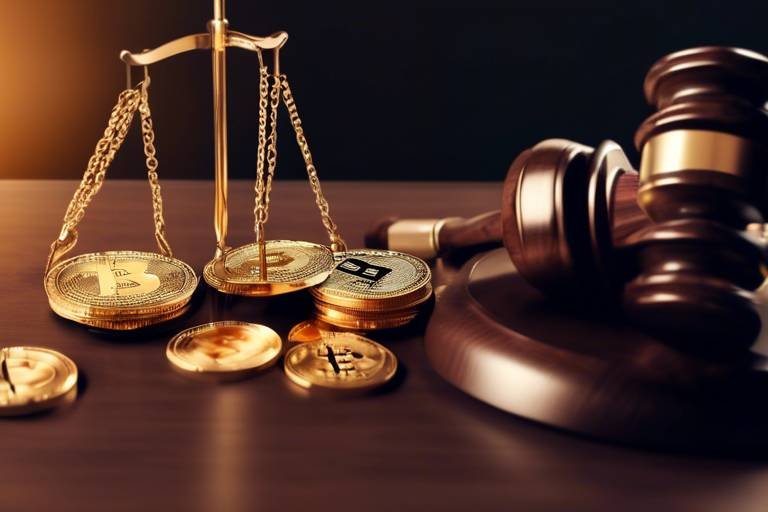The Importance of Legal Frameworks in Crypto Custody Solutions
In the rapidly evolving world of cryptocurrencies, the term crypto custody has become a buzzword, particularly as investors seek ways to secure their digital assets. But what does it really mean? At its core, crypto custody refers to the services and systems that protect and manage cryptocurrencies on behalf of users. With the surge of interest in digital currencies, the need for robust legal frameworks surrounding these custody solutions has never been more critical. After all, how can investors feel safe about their assets if there aren’t solid laws and regulations backing their security?
The role of legal frameworks in crypto custody is akin to the foundation of a house; without it, everything is at risk of collapsing. These frameworks not only ensure that custodians operate within the law but also protect investors from potential fraud and mismanagement. Think about it: would you trust a bank that wasn't regulated? The same principle applies to crypto custodians. By adhering to legal standards, custodians can enhance investor confidence and contribute to overall market stability, which is essential for the long-term growth of the cryptocurrency ecosystem.
Moreover, legal frameworks provide a structure for compliance, which helps custodians to implement best practices in security and risk management. This is particularly crucial given the decentralized nature of cryptocurrencies, which can make them susceptible to theft and hacking. By having clear regulations in place, custodians can better protect their clients' assets, thereby fostering a safer environment for all participants in the crypto market.
As we dive deeper into this topic, it’s essential to consider the various legal regulations that govern crypto custody. Different jurisdictions have their own sets of rules, and understanding these can feel like navigating a complex maze. However, this complexity also presents opportunities for custodians to differentiate themselves by adhering to the highest standards of compliance, ultimately leading to a more secure investment landscape.
In conclusion, the importance of legal frameworks in crypto custody solutions cannot be overstated. They serve as a safeguard for both individual and institutional investors, ensuring that their assets are managed responsibly and securely. As the cryptocurrency market continues to grow and evolve, the role of these legal frameworks will likely expand, shaping the future of digital asset management.
- What is crypto custody? Crypto custody refers to the services that securely hold and manage cryptocurrencies for investors.
- Why are legal frameworks important for crypto custody? They ensure compliance, protect investors, and enhance overall market stability.
- How do legal regulations impact custodians? Regulations guide custodians in implementing best practices and security measures, influencing their operational processes.
- What challenges do custodians face in legal compliance? Evolving regulations and cross-border complexities can make compliance a daunting task.
- What does the future hold for legal frameworks in crypto custody? As technology advances, legal frameworks are expected to evolve, providing clearer guidelines for custodians and enhancing security for investors.

Understanding Crypto Custody
In the ever-evolving world of digital assets, the term crypto custody has become a buzzword that is critical for both individual and institutional investors. But what does it really mean? At its core, crypto custody refers to the secure storage and management of cryptocurrencies. Just like you wouldn't leave your physical cash lying around, crypto custody solutions provide a safe place for your digital assets. These solutions are designed to protect cryptocurrencies from theft, loss, or unauthorized access, ensuring that your investments are as secure as possible.
Imagine you have a treasure chest, but instead of gold coins, it's filled with digital currencies like Bitcoin and Ethereum. This treasure chest needs to be locked up tight, and that's where custodians come into play. They act as the gatekeepers of your crypto assets, offering services that range from cold storage—where your assets are kept offline and away from potential hackers—to multi-signature wallets that require multiple approvals for transactions. This layered approach to security is essential in a landscape where cyber threats are omnipresent.
Crypto custody is not just about keeping your assets safe; it also plays a crucial role in the broader digital asset ecosystem. As cryptocurrencies gain traction and more people look to invest, the need for reliable custody solutions grows. Institutional investors, in particular, are keen on crypto custody services because they need assurance that their investments are managed in compliance with regulations and best practices. A robust custody solution can enhance investor confidence, which is vital for the overall health of the crypto market.
Furthermore, the significance of crypto custody extends beyond mere security. It also encompasses aspects of compliance and regulatory adherence. With the increasing scrutiny from regulators around the world, having a reliable custodian can help investors navigate the complex legal landscape. A reputable custodian will not only safeguard your assets but also ensure that all transactions comply with local and international regulations, thus minimizing risks associated with legal issues.
To sum it up, crypto custody is a foundational element in the realm of digital assets. It provides a secure environment for storing cryptocurrencies, instills confidence among investors, and ensures compliance with legal frameworks. As the crypto market continues to mature, the importance of effective custody solutions will only increase, making it essential for both new and seasoned investors to understand this critical aspect of the digital asset ecosystem.

Legal Regulations Governing Crypto Custody
In the rapidly evolving landscape of cryptocurrencies, legal regulations governing crypto custody are essential to ensuring that both individual and institutional investors can safely manage their digital assets. These regulations serve as a framework that custodians must navigate to protect their clients' investments and maintain market integrity. Understanding these regulations is crucial, as they not only dictate how custodians operate but also influence investor confidence and the overall stability of the crypto market.
Different jurisdictions have adopted various approaches to regulating crypto custody, leading to a patchwork of compliance requirements that custodians must adhere to. For instance, in some countries, custodians are required to obtain specific licenses, while others may impose strict capital requirements or mandate insurance coverage for digital assets. This regulatory diversity can create challenges for custodians, particularly those operating internationally, as they must ensure compliance across multiple legal landscapes.
Moreover, the legal regulations governing crypto custody often include provisions aimed at protecting investors. These provisions may require custodians to implement robust security measures, conduct regular audits, and maintain transparency in their operations. Such requirements not only safeguard assets but also enhance trust among users, who are more likely to engage with custodians that demonstrate a commitment to compliance and security.
Financial authorities play a pivotal role in establishing guidelines and regulations for crypto custody solutions. By setting standards that custodians must follow, these authorities ensure that best practices are maintained across the industry. This oversight helps to mitigate risks associated with digital asset management, such as fraud or mismanagement. For example, regulatory bodies may require custodians to implement multi-signature wallets or cold storage solutions to enhance security. These measures are designed to protect client assets from potential threats, including hacking and theft.
The distinction between international and domestic regulations is significant in the realm of crypto custody. While some countries have embraced a proactive approach to regulating digital assets, others remain hesitant, leading to inconsistent legal frameworks. For instance, the European Union has been working towards harmonizing regulations across member states, while the United States has a more fragmented approach, with different states imposing their own rules.
This disparity presents challenges for custodians who operate in multiple jurisdictions. They must navigate a complex web of regulations, each with its own compliance requirements and legal nuances. However, this complexity can also be advantageous. Custodians that successfully adapt to varying regulations can position themselves as industry leaders, offering secure and compliant services that appeal to a global client base.
Legal regulations significantly influence the operational practices of crypto custodians. Compliance with these regulations often necessitates the implementation of comprehensive risk management strategies. Custodians must regularly assess their security protocols, conduct due diligence on clients, and maintain accurate records to demonstrate compliance. Furthermore, as regulations evolve, custodians must remain vigilant and adapt their operations accordingly.
For instance, custodians may need to invest in advanced technology solutions to ensure compliance with data protection laws or to enhance their security infrastructure. This proactive approach not only helps custodians meet legal requirements but also fosters a culture of security and trust, which is vital in the crypto space.
In conclusion, legal regulations governing crypto custody are an essential component of the digital asset ecosystem. They provide a framework that enhances security, promotes investor confidence, and supports market stability. As the regulatory landscape continues to evolve, custodians must remain agile and responsive, ensuring that they not only comply with existing laws but also anticipate future changes.
- What is crypto custody? Crypto custody refers to the services provided by custodians to securely store and manage digital assets on behalf of clients.
- Why are legal regulations important for crypto custody? Legal regulations help ensure the security and compliance of custody services, enhancing investor confidence and market stability.
- How do different jurisdictions approach crypto custody regulations? Jurisdictions vary in their regulatory frameworks, with some requiring licenses and others imposing strict compliance measures.
- What role do financial authorities play in crypto custody? Financial authorities establish guidelines and regulations that custodians must follow to ensure best practices and security standards.
- What challenges do custodians face in legal compliance? Custodians must navigate evolving regulations, cross-border compliance complexities, and adapt to varying legal landscapes.

The Role of Financial Authorities
When it comes to the world of cryptocurrency custody, financial authorities play a pivotal role that cannot be overlooked. These institutions are not just the watchful guardians of the financial system; they are the architects of the regulatory frameworks that shape how cryptocurrencies are stored and managed. Think of them as the referees in a game; without them, the players might not follow the rules, leading to chaos and uncertainty. They ensure that custodians adhere to strict guidelines, thereby protecting both individual and institutional investors.
Financial authorities, such as the U.S. Securities and Exchange Commission (SEC) and the European Securities and Markets Authority (ESMA), have been instrumental in developing regulations that govern crypto custody solutions. Their guidelines aim to ensure that custodians implement robust security measures, conduct regular audits, and maintain transparency in their operations. This not only enhances security but also builds investor confidence, which is crucial for the long-term stability of the digital asset market.
Moreover, these authorities often engage in public consultations to gather insights from various stakeholders, including crypto custodians, investors, and legal experts. This collaborative approach helps them craft regulations that are not only effective but also practical. For instance, when considering the implementation of anti-money laundering (AML) and know-your-customer (KYC) protocols, financial authorities take into account the unique challenges posed by the digital asset landscape. They aim to strike a balance between fostering innovation and ensuring consumer protection.
It’s essential to recognize that the role of financial authorities extends beyond just regulation; they also provide guidance and support to custodians. Many authorities offer resources and training programs to help custodians understand their legal obligations and best practices. This proactive approach is vital in an industry that is constantly evolving, as it equips custodians with the knowledge they need to navigate the complexities of compliance.
In summary, financial authorities serve as the backbone of the crypto custody ecosystem. They establish the rules of the game, ensuring that all players operate under a framework that promotes security, transparency, and investor protection. Without their involvement, the crypto custody landscape could become a breeding ground for fraud and mismanagement, ultimately undermining the trust that is so essential for the growth of the cryptocurrency market.

International vs. Domestic Regulations
When it comes to the world of crypto custody, the regulatory landscape can feel like a complex labyrinth. Navigating through international and domestic regulations is akin to trying to solve a Rubik's cube—each twist and turn reveals new challenges and opportunities. On one hand, we have international regulations that aim to create a standardized framework for digital assets across borders, while on the other hand, domestic regulations cater to the specific needs and concerns of individual countries.
International regulations often stem from agreements among multiple countries to ensure a cohesive approach to digital asset management. These regulations can promote cross-border transactions and enhance investor confidence by providing a level of consistency in how cryptocurrencies are treated globally. For example, organizations like the Financial Action Task Force (FATF) have developed guidelines that member countries are encouraged to adopt, focusing on anti-money laundering (AML) and combating the financing of terrorism (CFT). However, the challenge lies in the fact that not all countries have the same level of commitment or capacity to implement these guidelines, leading to a fragmented regulatory environment.
On the flip side, domestic regulations are tailored to address local market conditions and investor needs. Countries like the United States, the European Union, and Japan have developed their own frameworks that reflect their unique economic landscapes and legal traditions. For instance, the U.S. has a patchwork of state and federal regulations that can sometimes create confusion for crypto custodians who wish to operate across state lines. Conversely, the EU is working towards a more unified approach through the Markets in Crypto-Assets (MiCA) regulation, which aims to harmonize rules across member states.
One of the significant challenges in this dichotomy is the inconsistency in regulatory approaches. For instance, while some countries embrace cryptocurrencies and create favorable conditions for their growth, others impose strict bans or heavy restrictions. This inconsistency can lead to regulatory arbitrage, where companies choose to operate in jurisdictions with more lenient regulations, potentially compromising security and compliance standards.
To illustrate the differences between international and domestic regulations, consider the following table:
| Aspect | International Regulations | Domestic Regulations |
|---|---|---|
| Scope | Global applicability | Country-specific |
| Consistency | Varied implementation | Uniform within the country |
| Flexibility | Less flexible; requires consensus | More adaptable to local needs |
| Compliance Costs | Potentially higher due to complexity | Variable, often lower for local firms |
In conclusion, understanding the nuances between international and domestic regulations is crucial for crypto custodians. They must not only comply with local laws but also stay informed about international guidelines to ensure they are operating within a safe and secure framework. As the crypto market continues to evolve, so too will the regulatory landscape, making it imperative for custodians to be agile and proactive in their compliance strategies.

Impact on Custodian Operations
The impact of legal regulations on custodian operations in the cryptocurrency space cannot be overstated. These regulations serve as a double-edged sword; while they impose strict compliance requirements, they also create a framework that enhances the overall security and trustworthiness of crypto custody solutions. For custodians, understanding and adapting to these regulations is essential for maintaining not only their operational integrity but also their reputation in the market. Without a solid legal foundation, custodians risk falling into legal pitfalls that could jeopardize their business and the assets they safeguard.
One of the most significant ways legal regulations affect custodian operations is through risk management practices. Custodians are required to implement robust security measures to protect digital assets from theft or loss. This includes rigorous due diligence processes, regular audits, and comprehensive insurance policies. For instance, a custodian may need to invest in advanced cybersecurity technologies to comply with regulations that mandate a specific level of asset protection. The costs associated with these measures can be substantial, but they are necessary to foster investor confidence and ensure long-term viability.
Moreover, compliance with legal frameworks often necessitates the establishment of dedicated compliance teams within custodial organizations. These teams are responsible for monitoring changes in regulations, assessing the impact on existing operations, and ensuring that all practices align with the latest legal requirements. This can create a more structured and secure environment for managing digital assets, but it also adds layers of complexity to the operational workflow.
Another crucial aspect is how legal frameworks can dictate the types of assets that custodians are allowed to handle. Some jurisdictions may have restrictions on which cryptocurrencies can be held in custody, potentially limiting the offerings of custodians. This not only affects the custodian's market competitiveness but also impacts the choices available to investors. For example, a custodian operating in a jurisdiction with stringent regulations may only be able to offer custody services for well-established cryptocurrencies like Bitcoin and Ethereum, while neglecting emerging tokens that could attract a different investor demographic.
Additionally, the legal landscape can influence how custodians interact with other financial institutions. Partnerships with banks and other financial entities often hinge on compliance with regulations. A custodian that demonstrates a strong commitment to legal adherence can foster better relationships with these institutions, which can lead to improved service offerings and enhanced credibility in the eyes of clients.
In summary, the legal regulations governing crypto custody have a profound impact on custodian operations. From shaping risk management strategies to influencing asset offerings and inter-institutional relationships, these frameworks play a pivotal role in the functioning of custodians. As the crypto landscape continues to evolve, custodians must remain agile, continuously adapting to the changing legal environment to maintain their competitive edge and ensure the security of the assets they manage.
- What are crypto custodians? Crypto custodians are specialized entities that securely store and manage digital assets on behalf of individuals and institutions.
- Why are legal frameworks important for crypto custody? Legal frameworks ensure that custodians operate within a regulated environment, enhancing security and building investor trust.
- How do regulations affect the types of cryptocurrencies custodians can manage? Regulations may impose restrictions on certain cryptocurrencies, limiting custodians to only those that comply with local laws.
- What role do compliance teams play in custodial operations? Compliance teams monitor regulatory changes and ensure that custodians adhere to legal requirements, thereby safeguarding the organization from legal pitfalls.

Investor Protection Mechanisms
In today's fast-paced digital economy, where cryptocurrencies are gaining traction and becoming mainstream, the need for robust has never been more critical. These mechanisms are essential to ensure that both individual and institutional investors feel secure while navigating the often volatile waters of crypto custody. So, what exactly do these protections entail, and why are they so vital?
First and foremost, legal frameworks surrounding crypto custody solutions often include a variety of insurance policies designed to protect investors against potential losses due to theft, hacking, or operational failures. For instance, custodians may carry insurance that covers the assets they hold on behalf of clients. This insurance acts as a safety net, providing peace of mind to investors who might otherwise hesitate to entrust their digital assets to a third party.
Moreover, regulatory bodies impose strict compliance requirements on custodians to ensure they implement effective security measures. These measures often include advanced encryption technologies, multi-signature wallets, and regular security audits. Such stringent requirements are not just bureaucratic red tape; they are designed to create a secure environment where investors can rest assured that their assets are well-protected.
Another essential aspect of investor protection is the establishment of clear dispute resolution mechanisms. In the event of a disagreement between a custodian and an investor, having a predefined process for resolving disputes can significantly reduce anxiety and uncertainty. This might involve mediation or arbitration, which are often more efficient and less costly than traditional legal proceedings.
Additionally, transparency plays a crucial role in fostering trust between custodians and their clients. Regular reporting and audits not only help custodians maintain compliance but also provide investors with a clear picture of their assets' status. When custodians share information about their operational practices and security measures, it builds a foundation of trust that is vital in the crypto space.
Furthermore, the implementation of know-your-customer (KYC) and anti-money laundering (AML) procedures is another layer of protection for investors. By verifying the identities of their clients, custodians can mitigate the risk of fraud and ensure that they are not inadvertently facilitating illegal activities. This not only protects the custodian but also enhances the overall integrity of the crypto market.
In summary, the mechanisms designed to protect investors in the realm of crypto custody are multifaceted and essential. They encompass insurance coverage, compliance with stringent regulations, clear dispute resolution processes, transparency in operations, and robust KYC and AML practices. Together, these elements create a safer environment for investors, fostering trust and confidence in the burgeoning world of digital assets.
- What are investor protection mechanisms in crypto custody?
These mechanisms include insurance policies, compliance requirements, dispute resolution processes, transparency measures, and KYC/AML practices designed to safeguard investors' assets.
- How do insurance policies work in crypto custody?
Custodians may carry insurance that protects against losses due to theft, hacking, or operational failures, providing a safety net for investors.
- Why is transparency important in crypto custody?
Transparency fosters trust between custodians and clients by providing regular reports and audits, allowing investors to understand the status of their assets.

Challenges in Legal Compliance
The world of crypto custody is not just about securing digital assets; it’s also about navigating a labyrinth of legal compliance challenges. As the crypto landscape evolves, so too do the regulations that govern it, leaving custodians in a constant state of adaptation. One of the most significant hurdles they face is the rapidly changing regulatory environment. Just when they think they have a handle on the rules, new guidelines or amendments can emerge, rendering their existing compliance frameworks obsolete. This unpredictability can lead to operational inefficiencies and increased costs as custodians scramble to update their systems and processes.
Moreover, the complexity of cross-border compliance adds another layer of difficulty. Different jurisdictions have unique regulations, and what is acceptable in one country may not be in another. This fragmentation can create a scenario where custodians must tailor their operations to meet a patchwork of rules, which not only complicates compliance but also heightens the risk of inadvertent violations. For instance, a custodian operating in both the U.S. and Europe must navigate the differences in AML (Anti-Money Laundering) and KYC (Know Your Customer) requirements, leading to potential legal pitfalls.
In addition to these challenges, custodians often face significant resource constraints. Smaller firms, in particular, may lack the financial and human resources necessary to keep up with compliance demands. As regulations become more stringent, the need for specialized legal and compliance staff increases, which can strain the budgets of smaller custodians. This situation creates a dilemma: invest in compliance or risk legal repercussions that could jeopardize their business.
Another critical aspect is the ambiguity in regulations. Many existing laws were not designed with cryptocurrencies in mind, leading to vague interpretations that can leave custodians uncertain about their obligations. This uncertainty can stifle innovation and growth, as companies may be hesitant to launch new services or products without clear guidance on how they fit within the legal framework.
To illustrate these challenges, consider the following table that summarizes key compliance issues faced by crypto custodians:
| Compliance Challenge | Description |
|---|---|
| Rapid Regulatory Changes | Frequent updates to laws can render existing compliance measures ineffective. |
| Cross-Border Regulations | Different jurisdictions have varying requirements, complicating compliance efforts. |
| Resource Constraints | Smaller firms may struggle to allocate sufficient resources for compliance. |
| Regulatory Ambiguity | Vague laws create uncertainty, hindering innovation and service development. |
In conclusion, the challenges of legal compliance in crypto custody are multifaceted and ever-evolving. Custodians must be proactive in their approach, constantly monitoring the regulatory landscape and adapting their practices accordingly. By doing so, they can not only mitigate risks but also foster a culture of trust and security that is essential for the growth of the digital asset ecosystem.
- What is the biggest challenge for crypto custodians regarding compliance?
The biggest challenge is navigating the rapidly changing regulatory environment, which can lead to operational inefficiencies. - How do cross-border regulations affect crypto custodians?
They create a complex landscape where custodians must comply with different laws in various jurisdictions, increasing the risk of inadvertent violations. - Why is regulatory ambiguity a concern?
Vague regulations can lead to uncertainty, making it difficult for custodians to understand their legal obligations.

Adapting to Regulatory Changes
In the fast-paced world of cryptocurrency, the only constant is change. Regulatory frameworks are evolving rapidly, and crypto custodians must be agile to keep up. Imagine trying to dance to a song that keeps changing its tempo; that’s the challenge faced by custodians in this dynamic landscape. To thrive, they need to develop a robust strategy for adapting to these regulatory shifts.
One effective approach is to establish a dedicated compliance team that stays informed about the latest regulations and trends. This team acts like a lighthouse, guiding the organization through the murky waters of compliance. Regular training sessions can ensure that all employees are well-versed in the current laws and can implement necessary changes swiftly. Additionally, custodians can leverage technology to automate compliance processes, making it easier to adapt to new rules as they emerge.
Moreover, engaging with regulators and industry bodies can provide custodians with insights into upcoming changes. By participating in discussions and consultations, they can not only stay ahead of the curve but also influence the regulatory landscape. This proactive engagement is crucial, as it fosters a collaborative environment where custodians can voice their concerns and contribute to the development of sensible regulations.
Another key aspect of adaptation is maintaining flexible operational structures. Custodians should design their systems and processes with adaptability in mind. This means creating frameworks that can be easily modified without significant overhauls. For instance, if a new regulation requires enhanced security measures, a custodian with a flexible infrastructure can implement these changes more seamlessly than one with rigid systems.
In summary, adapting to regulatory changes is not just about compliance; it’s about resilience and foresight. Crypto custodians need to embrace change as an opportunity rather than a challenge. By investing in compliance teams, leveraging technology, engaging with regulators, and maintaining flexible operations, they can navigate the ever-changing regulatory environment effectively and continue to provide secure services to their clients.
- What are the main challenges crypto custodians face in adapting to regulatory changes?
Crypto custodians often struggle with the rapid pace of regulatory change, the complexity of compliance requirements, and the need to balance security with flexibility. - How can technology assist in regulatory compliance?
Technology can streamline compliance processes through automation, data management, and real-time monitoring, making it easier for custodians to adapt to new regulations. - Why is engaging with regulators important for crypto custodians?
Engaging with regulators allows custodians to stay informed about upcoming changes and advocate for sensible regulations that benefit the industry. - What role does staff training play in compliance?
Regular training ensures that all employees are aware of current regulations and understand how to implement necessary changes in their daily operations.

Best Practices for Compliance
In the rapidly evolving world of cryptocurrency, ensuring compliance with legal frameworks is not just a regulatory requirement; it’s a necessity for building trust and credibility in the market. Crypto custodians must adopt a proactive approach to compliance, integrating best practices that not only meet legal obligations but also enhance their operational integrity. One of the fundamental practices is to establish a robust compliance program that is tailored to the specific risks associated with digital assets. This program should include regular audits, employee training, and the implementation of comprehensive policies that align with both local and international regulations.
Moreover, custodians should leverage technology to streamline their compliance processes. Utilizing advanced software solutions can help automate reporting, monitor transactions for suspicious activities, and ensure that all necessary documentation is maintained. This technological edge not only facilitates compliance but also significantly reduces the chances of human error, which can lead to costly penalties. In addition, custodians should foster a culture of transparency and accountability within their organizations. By encouraging open communication about compliance issues and maintaining a whistleblower policy, custodians can create an environment where employees feel empowered to report potential violations without fear of retaliation.
Another critical aspect of compliance is staying informed about regulatory changes. The legal landscape for cryptocurrencies is constantly shifting, and custodians must remain agile to adapt to these changes effectively. Engaging with legal experts and participating in industry forums can provide custodians with insights into upcoming regulations and best practices from peers. Furthermore, establishing strong relationships with regulatory bodies can facilitate smoother compliance processes and enhance the custodian's reputation in the industry.
To summarize, the best practices for compliance in crypto custody solutions include:
- Developing a tailored compliance program
- Utilizing technology for automation and monitoring
- Fostering a culture of transparency
- Staying updated with regulatory changes
- Building relationships with regulators
By adhering to these best practices, crypto custodians can not only ensure compliance but also contribute to a more secure and trustworthy environment for all participants in the digital asset ecosystem. As the market matures, those who prioritize compliance will likely emerge as leaders in the industry, attracting more clients and gaining a competitive edge.
Q1: What are the main legal frameworks affecting crypto custody?
A1: The main legal frameworks vary by jurisdiction but generally include anti-money laundering (AML) laws, know your customer (KYC) regulations, and securities laws. Understanding these regulations is crucial for custodians to operate legally and effectively.
Q2: How can custodians ensure they remain compliant with changing regulations?
A2: Custodians can ensure compliance by regularly reviewing their policies, investing in compliance technology, and engaging with legal experts. Staying informed about regulatory developments through industry associations and forums is also beneficial.
Q3: Why is compliance important for crypto custodians?
A3: Compliance is essential for maintaining trust with clients, avoiding legal penalties, and contributing to the overall stability of the cryptocurrency market. It helps custodians build a reputation for reliability and security.
Q4: What role does technology play in compliance?
A4: Technology plays a significant role in compliance by automating processes, enabling real-time monitoring of transactions, and ensuring accurate record-keeping. This reduces the risk of errors and enhances the custodian's ability to comply with regulations.

The Future of Legal Frameworks in Crypto Custody
The landscape of crypto custody is evolving at an unprecedented pace, driven by technological advancements and a growing demand for regulatory clarity. As cryptocurrencies become more mainstream, the need for robust legal frameworks that can adapt to the dynamic nature of digital assets is becoming increasingly crucial. Imagine a world where the rules governing crypto custody are as clear and reliable as those for traditional banking; this is the future many stakeholders are advocating for.
One of the most significant trends shaping the future of legal frameworks in crypto custody is the integration of blockchain technology with regulatory compliance. This integration promises to enhance transparency and security in the custody of digital assets. With smart contracts and decentralized ledgers, custodians can automate compliance checks, ensuring that they meet regulatory requirements while minimizing human error. This not only streamlines operations but also builds trust with investors who are increasingly wary of the risks associated with digital assets.
Furthermore, as the regulatory environment continues to mature, we can expect to see a more harmonized approach to crypto custody regulations across different jurisdictions. Currently, the disparity in regulations can create confusion and uncertainty for custodians operating on a global scale. However, as international bodies collaborate to establish common standards, custodians will benefit from clearer guidelines that facilitate cross-border operations. This evolution could lead to a more stable market, fostering greater investor confidence.
In addition, the rise of decentralized finance (DeFi) is pushing traditional custodians to rethink their roles. As DeFi platforms gain popularity, the legal frameworks surrounding crypto custody will need to evolve to accommodate these new models. Custodians may have to adapt by offering services that support DeFi protocols while ensuring compliance with existing regulations. This adaptation could lead to innovative custody solutions that cater to a broader range of investors, from individual traders to large institutions.
Moreover, the future will likely see an increased emphasis on investor protection mechanisms. As more individuals enter the crypto space, the demand for security and trust will rise. Legal frameworks will need to incorporate measures that protect investors from fraud and mismanagement. This could involve stricter licensing requirements for custodians, mandatory insurance for digital assets, and enhanced reporting obligations. By prioritizing investor protection, the industry can foster a safer environment that encourages more people to engage with cryptocurrencies.
Finally, it is essential to recognize the role of education in the future of legal frameworks in crypto custody. As regulations become more complex, custodians will need to invest in educating their clients about compliance requirements and best practices. This education will not only empower investors but also help custodians maintain their reputations as trusted partners in the digital asset ecosystem. By fostering a culture of transparency and knowledge-sharing, the entire industry can thrive.
- What is crypto custody? Crypto custody refers to the secure storage and management of cryptocurrencies and digital assets by custodians, ensuring their safety from theft or loss.
- Why are legal frameworks important for crypto custody? Legal frameworks provide guidelines and regulations that custodians must follow, enhancing security, compliance, and investor confidence.
- How will the future of crypto custody evolve? The future will likely involve more harmonized regulations, integration with DeFi, enhanced investor protection, and a focus on education.
- What challenges do custodians face in compliance? Custodians face challenges such as evolving regulations, cross-border compliance complexities, and the need to adapt to new technologies.
Frequently Asked Questions
- What is crypto custody and why is it important?
Crypto custody refers to the secure storage and management of cryptocurrencies on behalf of individual or institutional investors. It's crucial because it safeguards digital assets against theft, loss, or unauthorized access, thereby enhancing investor confidence and ensuring market stability.
- How do legal frameworks impact crypto custody solutions?
Legal frameworks provide the necessary guidelines and regulations that custodians must follow to ensure compliance and security. They help establish standards for risk management, operational practices, and investor protection, ultimately fostering trust in the cryptocurrency market.
- What are the main legal regulations governing crypto custody?
Various legal regulations impact crypto custody, including anti-money laundering (AML) laws, know your customer (KYC) requirements, and securities regulations. These laws can vary significantly between jurisdictions, creating a complex landscape for custodians to navigate.
- How do financial authorities influence crypto custody?
Financial authorities play a pivotal role by establishing guidelines and regulations that custodians must adhere to. They ensure that custodians follow best practices in security and compliance, which helps protect investors and maintain market integrity.
- What are the challenges faced by crypto custodians in legal compliance?
Crypto custodians face several challenges in legal compliance, including rapidly evolving regulations, the complexity of cross-border compliance, and the need for continuous adaptation to new legal requirements. This can make it difficult for custodians to maintain consistent operations while ensuring compliance.
- What best practices can custodians adopt for compliance?
Custodians can adopt several best practices for compliance, such as implementing robust security measures, conducting regular audits, staying updated on regulatory changes, and fostering a culture of compliance within their organizations. These practices help create a secure and trustworthy environment for digital asset management.
- What does the future hold for legal frameworks in crypto custody?
The future of legal frameworks in crypto custody is likely to evolve alongside technological advancements and increasing demand for regulatory clarity. As the industry matures, we can expect more standardized regulations that enhance security and investor protection while promoting innovation.



















